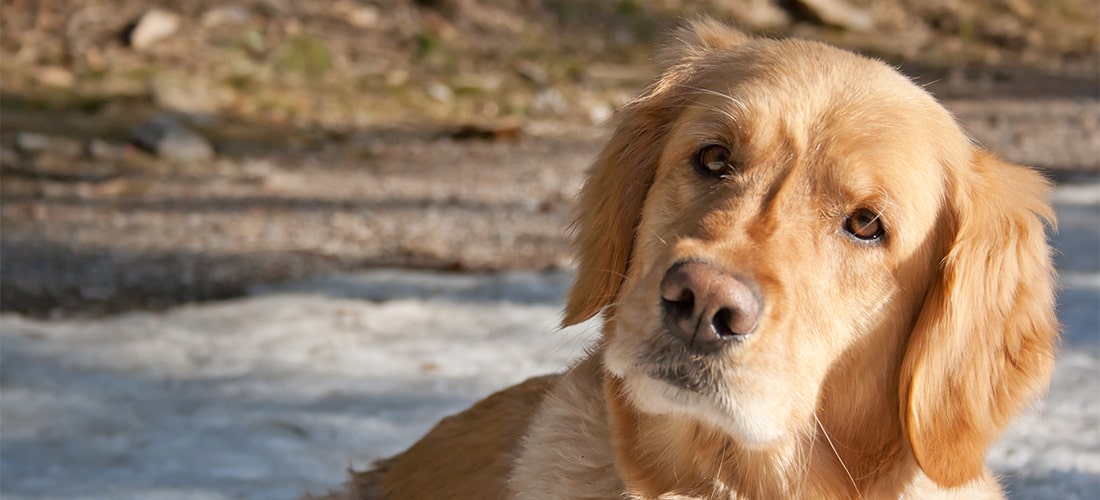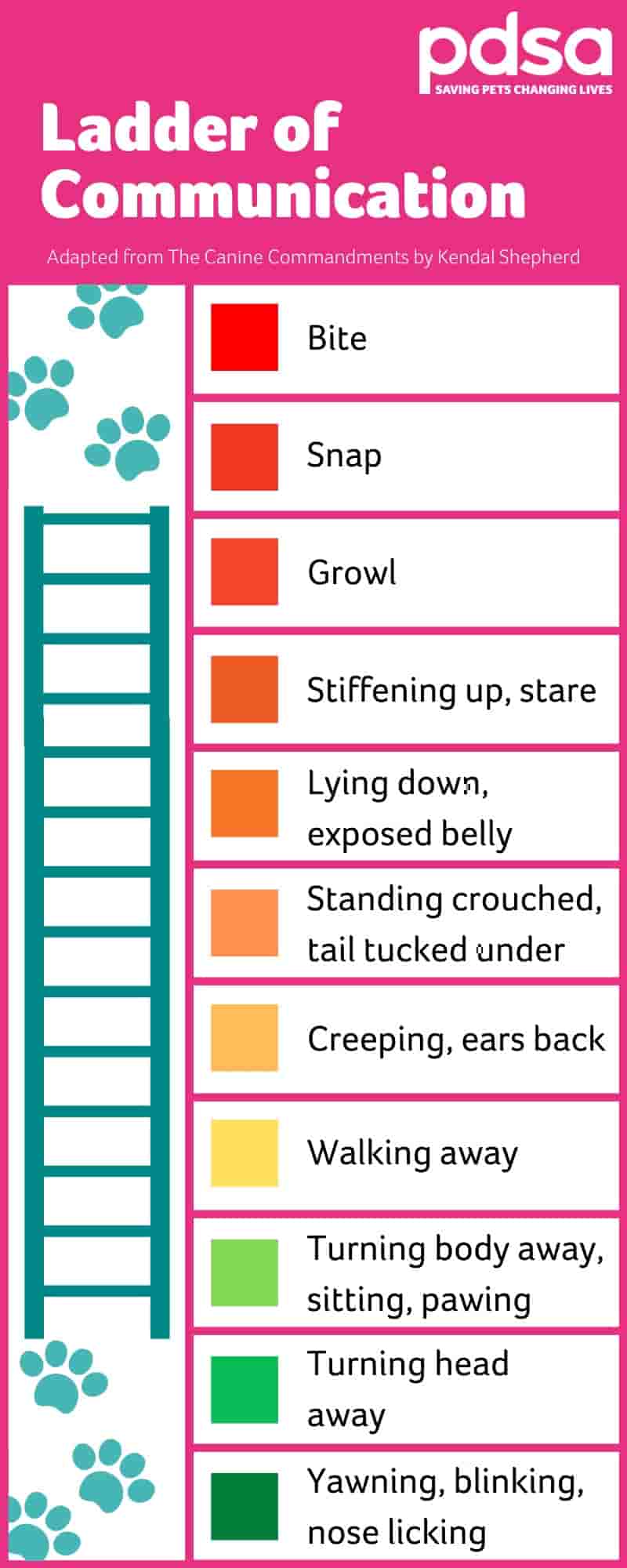Canine communication: recognising stress in your dog
Our dogs tend to tell us how they are feeling through their body language, but sometimes it can be easy to miss the signs. We’re looking at how Kendal Shepherd’s ladder of communication can help owners.
Dogs can find a lot of different situations stressful for lots of reasons. Some owners often don’t realise their dog is unhappy until they growl or snap, but most of the time they actually give us a lot of warning signs long before this.
Check out our info below to help you recognise unhappiness and stress in your dog.
What is the ladder of communication?

How a dog reacts to something they find stressful can be thought of as a series of steps on a ladder. This idea of a ladder of communication was developed by leading dog behaviourist Kendal Shepherd based on her experience working with dogs and is widely used by others in the animal welfare world.
Each step covers different signals dogs show through their body language to communicate with people and other animals they’re feeling uncomfortable or stressed. As a dog gets more upset, their body language may change according to the steps on the ladder.
The sooner we can pick up on the earlier steps, we can stop whatever the dog is finding stressful which means they won’t move ‘up’ the ladder. The lower signs are really common and if you start to look out for them, you’ll see them often when a dog is challenged. Spotting these early signs is a good way to understand how your dog is feeling in different situations.
If the early signals are not being listened to, your dog might start to go ‘up’ the ladder to try and get the situation to stop. If it doesn’t, then they feel like they need to use more and more obvious body language, right up to what we see as aggression (growling, snapping and even biting).
Sometimes, if a dog has learned over time that their more mild signals (lower on the ladder) aren’t listened to, they might skip some steps on the ladder and jump straight to higher levels. This is why it’s always better to pay attention to what dogs are trying to tell you and help them get out of stressful situations, so that they don’t feel like they have to jump higher on the ladder to get people to listen.
Not every dog will show every behaviour on the ladder and might not follow the specific order.
What are the steps?
Yawning, blinking, nose licking
- Yawns can indicate tiredness, but are more often a way to relieve tension from the dog’s jaw. This can be the first sign that a dog feels uncomfortable.
- Licking their own nose can act as a self-comforting behaviour, like when children suck their thumbs, so if you see this in a dog then they might be stressed and trying to calm themselves. Sometimes they will also lick the nose or face of person or animal they want to leave them alone, to show that they are not returning a threat.
- Dogs might also lift a paw to try and calm the situation.
- Blinking and closing both eyes are also signs that they are trying to show they're not a threat.
Looking away
- People face each another when we speak and turn our heads away when the conversation has finished. Dogs have a similar way of telling us that they are ready to finish with a social situation.
- Sometimes they won't turn their head but they’ll look away with their eyes and you’ll see the white of their eyes. This is a clear sign the dog is feeling uncomfortable.
Turning body away, sitting, pawing
- If your dog is looking away from something, especially if they turn their whole body away or sit down but keep pawing someone away, then they are asking for space. Help them get out of the situation to reduce their stress.
Walking away
- Dogs may try and be clear that they don’t like a situation by walking away.
- This is their way of taking themselves out of situation that’s making them uncomfortable. Allow them to do this as blocking their escape can send them up the ladder.
Creeping, ears back
- Creeping is a more expressive way of showing they are worried or want space.
- When creeping, a dog will usually look more nervous and you may be able to see the whites of their eyes when walking away. They may also raise a paw up or lick their lips.
- Often, they will slink low to the ground as they try to move away slowly.
Standing crouched, tail tucked under
- This shows the dog is feeling very unsure, but trying to calm the situation and make themselves seem smaller and less threatening.
- It usually means that they are very nervous so giving them some space is the best thing to do.
Lying down, exposed belly
- The dog is showing they are very worried and is trying to make peace with whoever is threatening to them.
- This position is different to a playful roll and the dog may also seem frozen in place compared to the wiggliness that is seen with a playful roll.
- Not to be confused with a relaxed dog after playing or stroking who flops back for belly rubs.
Stiffening up, staring
- At this point, the dog is stressed enough that their fight-flight-or-freeze response is kicking in, they may stay very still until the perceived threat has gone away.
- If the threat doesn't go away or they can't escape, they might progress up the communication ladder by fighting to try to finally sort out the stressful situation.
Growl
- Growling is a clear sign that the dog is feeling distressed or afraid and is asking for space. With this they are giving an obvious and loud indication that they are not happy if other steps on the ladder have been ignored.
- You should never punish a dog for growling because you are more likely to just ‘train’ this step out of them and then dogs feel like they need to jump from lower down the ladder straight to a bite or a snap.
Snap
- Snapping is a clear warning to stay away and the dog is showing that they will act if they need to.
Bite
- If the other communication signals on the ladder have not stopped the threat (which might be a real threat or just something the dog thinks is scary), then the dog may have to resort to biting.
- This action is used to defend themselves and get rid of the threat.

Their language
Want to know if your pooch is feeling happy? We've covered the basics of body language so you know if your dog is happy or not!
Read the signsDog-friendly homes
A big part of keeping your dog happy is making sure you have a dog-friendly home. Read our top tips on giving your dog the perfect set-up.
The Perfect PadSomething special
Spending more time with your pup lately? Why not buy them a new toy or some tasty treats approved by our own vets?
Shop now
